Vinayak Varma on illustrating picture books
Posted by Remya Padmadas on August 14, 2017Vinayak Varma is an illustrator, writer and editor based in Bangalore. He is the author of 'Angry Akku', 'Jadav and the Tree-Place' (Pratham Books) and 'Up Down' (Tulika Books), and was the founder editor of Brainwave magazine. His articles and short stories have been published in The New Indian Express, DNA, Deccan Herald, The Hindu, Muse India and Out of Print Magazine, and he has illustrated books for Penguin, Harper Collins, Hachette, Scholastic, Duckbill and Pratham Books. You can visit Vinayak online at www.mixtape.in, instagram.com/mixtape.in and twitter.com/eyefry.
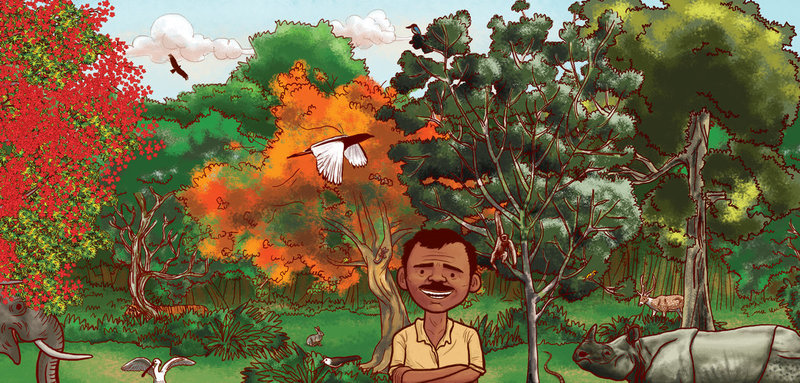
Vinayak is judging the 'Who is Ameena?' contest and shares some insights on illustrating for children's books for those of you planning to enter.
To start off with, here's a general overview of the process that I (and most other illustrators) follow:
1. Once I receive the brief for a book, I first try to identify a set of visual criteria that will work best for it:
- A governing style -- if I want to try something entirely new, which is different from the way I've drawn before, I create a mood board with a bunch of reference illustrations from various sources (Pinterest works particularly well for this purpose), and I try and spend some time at a good children's book store (like Lightroom in Bangalore) for some inspiration;
- The medium -- I decide what art materials I should use, how much of it should be traditional media, and how much can be digital, etc.;
- Visual research -- if I'm drawing an animal, for instance, I'll need photo references of that animal in various angles and poses. Similarly, for landscapes, buildings, flora, etc.
2. I then sketch character designs for the central protagonist(s) in the book. I do multiple iterations in several styles, so that I have varied options from which to choose.
3. Next, I make thumbnail drawings for all the illustrations -- these are very rough, and meant only to indicate the overall composition of each illustration. Along with these, I make one detailed drawing, as a proof of what the rest of the book will look like.
4. I then submit all these to the art director or editor I'm working with, for their approval.
5. Once approvals come in, and pending any corrections, I make detailed pencil sketches of all the pages (based on the thumbnails I already made), ink these drawings, and go ahead with the final colouring.
A few general tips and tricks:
-- You can build consistency in your artwork (and pose a fun creative challenge for yourself) by defining a very specific colour palette, and drastically limiting the number of inking and colouring tools you use. Visual consistency also comes from creating a strong internal logic for your style of illustration, and sticking to it. For example, some artists choose to draw characters' eyes as little black dots, some draw white circles with black dots, some draw them in the shape of large pomfrets, and some draw anatomically correct eyes. Similarly, there are the artists who draw buildings, landscapes and objects with perfect perspective and clean lines, while others may use a more impressionistic approach. What you choose to do in any of these instances is entirely up to you, but once you've made your choice, you need to stand by it for the rest of the book.
-- Your art should add a whole new dimension to the story. Instead of merely repeating what the text says, allow your illustrations to take creative liberties, and add interesting details that go beyond what the writer has suggested. Remember that picture books always have two authors -- both the writer and the illustrator are creative equals in this medium, working in tandem but with distinct viewpoints -- so don't be shy of exerting your unique authorial and artistic vision.
-- Having fun while illustrating is important, of course, but it might also benefit your artwork to imagine that this might be your last and greatest work, and that everyone is going to judge the hell out of you based on how well this turns out. I often use this strategy to frighten myself into delivering (I hope) a somewhat-above-average product. And it works for the most part -- except when I allow the fear to paralyse me into a state of deep inertia... Hmm. On second thoughts, maybe this isn't the best advice in the world. Yeah, okay, forget I said anything. Just do that 'having fun' part.
In summary: look at lots of picture books before starting out, make strong artistic choices, take plenty of creative risks, and have fun.
For more details on 'The Who is Ameena?' contest and to enter, click here.
Be the first to comment.Pratham Books' One Day, One Story goes online in Season 9!
Posted by Pallavi Kamath on September 06, 2020It’s that time of the year again, for One Day, One Story – Pratham Books’ annual storytelling campaign celebrating International Literacy Day on September 8th. Last year, we had over 6700+ Reading Champions conducting 5500+ sessions, reaching out to 40,000+ children all across India with the stories of Gappu and Nila. And this year, we hope to make it extra special!
Why One Day, One Story?
To help children discover the joy of stories, and fall in love with reading. On September 8th every year, Pratham Books Champions all over India use two books to conduct reading sessions for children in their communities.
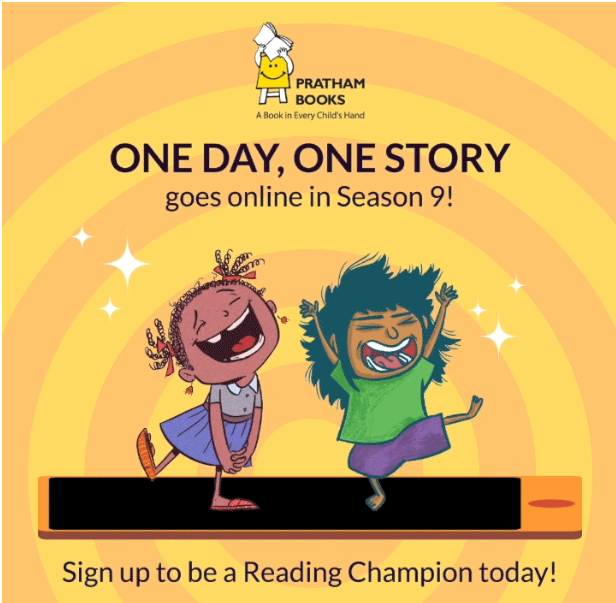
What’s the story?
Typically, One Day, One Story is a volunteer-led on-ground event where Reading Champions conduct storytelling sessions with groups of children all over India and the world. Due to the ongoing Covid-19 pandemic, this year is a little different, since children everywhere are still at home and on-ground storytelling sessions or book dispatches won’t be possible. So we’re taking One Day, One Story online, where we invite you to conduct virtual storytelling sessions and readalouds over the internet, to continue to spread the joy of reading far and wide!
The storybooks for One Day, One Story this year were chosen keeping in mind that children have been at home for many months now and could use a little bit of humour along with some insight on managing their emotions through these uncertain times. The two books for ODOS 2020 are Angry Akku, a Level 2 book written and illustrated by Vinayak Varma for younger kids, and The Girl Who Could Not Stop Laughing, a Level 3 book written by Meera Ganapathy and illustrated by ROSH for older kids.
How does this work?
You could conduct a storytelling session online – through Zoom or Whatsapp with a group of children, or on Facebook or Instagram Live.
OR you could record your storytelling of either (or both!) of the books on your mobile phone and share it on social media with the hashtag #OneDayOneStory2020 and then tag a friend to do a reading of the books! (Don’t forget to tag us too!) Check out some basic tips on how to record yourself telling the story.
Whichever storybook or platform you choose, we would love for you to use it in creative ways – read, narrate, enact… so that it’s fun for children to watch and listen to.
Sounds interesting? Mark your calendar for September 8, and join thousands of other Champions sharing their love for reading with the children who need it the most!
Note: If you have any queries, please mail [email protected] before you fill in the form.
Frequently Asked Questions
1. This is the first time I am conducting an event. How should I prepare for it?
Read the book a few times. If you are reading to a younger age group, see how you can tell the story without actually reading from the book (to retain their attention). Think of activities to engage the children after the storytelling. Alternatively, read a few more stories around the same theme.
2. Can I conduct multiple storytelling sessions online?
Oh, yes, you can! The aim is to reach as many kids as possible. You can do more than one session on more than one day, on or after September 8th.
3. Will I be receiving physical copies of the books?
Due to the Covid-19 pandemic and ensuing logistical difficulties, we will not be dispatching physical copies of the books and banners for One Day, One Story this year. But once you sign up, we’ll be happy to share e-copies of the books in multiple languages. You could read the story aloud from a digital device, like an iPad or a mobile phone, or you could print out the book and hold it up while you read.
4. Should I document the event?
Yes please! You can send us the storytelling video you make, a write-up and tag us on social media when you share your video – just share with us the “real impact” you’ve helped make.
5. I really want to conduct a session but I am not free on September 8? What should I do?
The aim of One Day, One Story is to spread the joy of stories. In case you are unable to, you can still conduct it on a day close to the chosen date. Because children getting to listen to a fun story is much more important than a date, right? This year, we are running One Day, One Story all through September 2020.
6. How do I do a virtual storytelling session?
Once you sign up for One Day, One Story, check out these tips on how to take a video of yourself reading out the story using a mobile phone. If you are conducting a live storytelling session with a group of children on Zoom, Whatsapp or Instagram/Facebook Live, you would need to keep in mind all the things you would normally do when doing a storytelling session in-person – the only difference this year is that it’s online!
Check out some online readaloud videos that others have done with our stories over the past few months here!
Sounds like something you would like to do?
Hop on board! Individuals sign up here and organisations can sign up here.
Illustrations by Vinayak Varma and ROSH
comments (10)Diversity in Children's Books: Why it Matters
Posted by Yamini Vijayan on July 01, 2016This year, we published a book called 'How Do Aeroplanes Fly?' on StoryWeaver in 10 languages. The book – written by Aditi Sarawagi and illustrated by Lavanya Karthik - was recently introduced to a group of children in Kota, Rajasthan, by a colleague during one of her field visits. One of the interesting observations she had made was that the children – both boys and girls – were struck by the mention of female pilots. “We didn't know that women could fly planes,” one of them had said to her. You can watch a related video here.
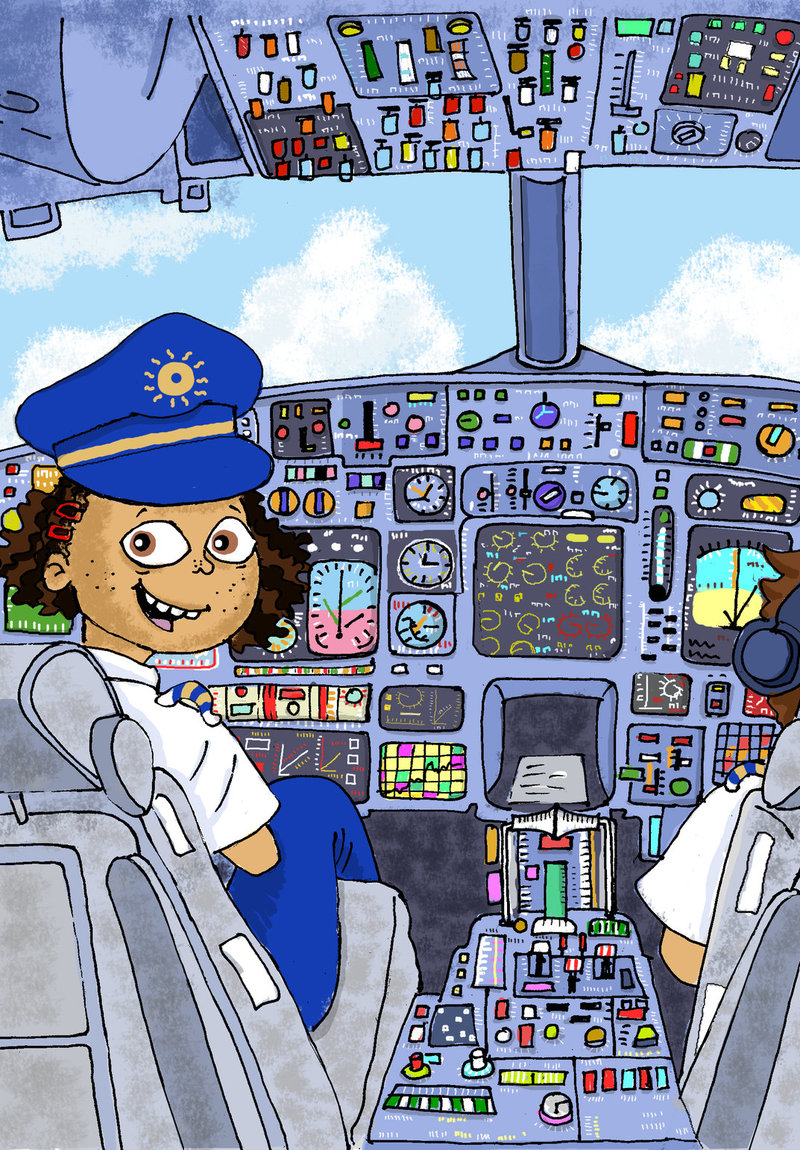
While I'm aware of disparities existing in every corner of India, this still took me by surprise. It also made me realize that all the thinking we do, as publishers, teachers and parents – which often feels like overthinking – is most definitely a good thing. Including a woman pilot and an Indian one at that had made a difference here, after all.
Over the last couple of years, there has been a lot of conversation around the growing need for diverse and inclusive books. And what does diversity mean, you ask. I suppose it could mean a range of things: from gender and religion, to language and ethnicity. The website We Need Diverse Books has listed down their vision as “A world in which all children can see themselves in the pages of a book." In India, initiatives like @genderlogindia and BAM! Books have actively helped keep this conversation alive.
In 2012, a national consultation involving experts from institutions, authors, editors, publishers, librarians and educators was organized by National Book Trust. 'The Good Books Guide', the document that emerged from this gathering, speaks about diversity and inclusion in its section on values. “There is a need to realize that many groups – and their world-view and perspectives – are often ignored in children's literature. For instance, girls, tribal or dalit children, children with special needs, working children and those living in urban slums, don't get enough representation in mainstream literature.”
When I think about the first set of books that were published on StoryWeaver (released digitally first), a few titles come to mind. To be completely honest though, it feels odd to be calling these books diverse. Why should a boy cooking be thought of as diverse? Why should a book featuring a single-parent household be slotted as diverse? Just because there are characters from the North-East of India, should a book be treated as diverse? Children living near a garbage dump... diverse?
Here's the thing though. There aren't enough children's books, especially in India, in which boys or men are shown to be cooking. Single-parent households in children's books? Hardly. Characters from the North-East? A handful. Well, you get the point. In a world in which children are surrounded with fear, prejudice and suspicion, these stories – which include multiple perspectives and help build empathy - become all the more important. Stories with diverse characters will help them realize that 'the other' – in any regard – is more like them than they had imagined. And that even if they weren't, these differences are to be celebrated.
If we want our children to be independent in their thinking, we certainly need to give them access to rich and eclectic narratives that not only only inspire curiosity, but also show rigid patterns being broken gracefully. In Ross Montgomery's recent article on 'Why Writing Diverse Children's Books is Tough', he addresses a lot of issues that well-meaning authors are likely to run into. After all, you don't want to include diverse characters in your book just for the sake of having diversity, do you? But as he points out, “We all have to strive to create well-rounded diverse characters and find new ways of writing. The fact that it’s hard isn’t a good enough excuse: we have to step away from the established paths and take more risks. Who knows - we might even find a better one.”
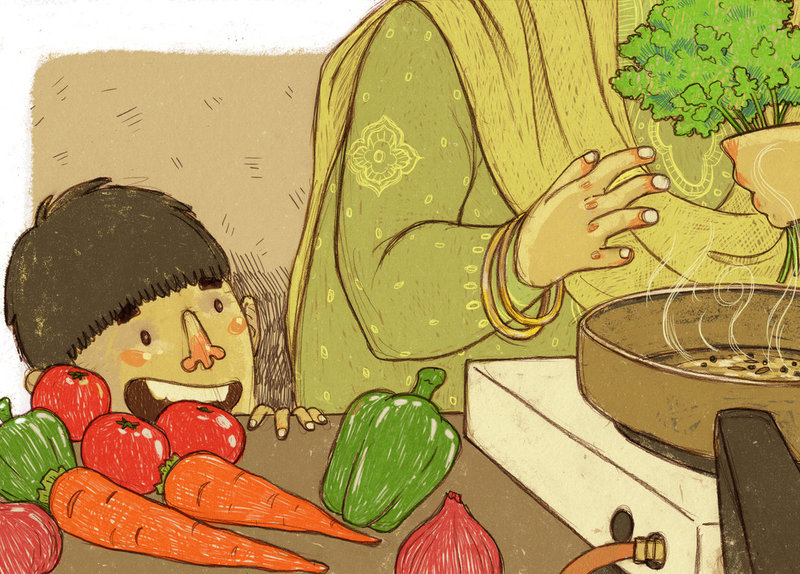
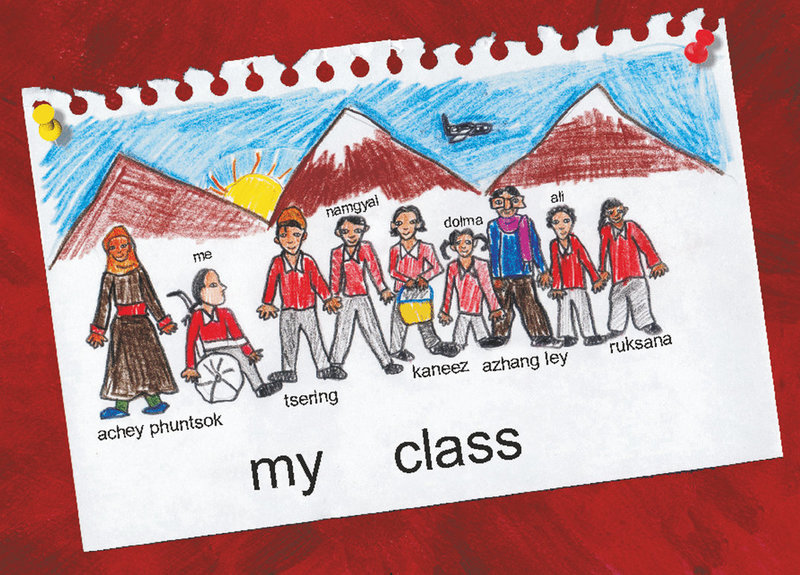
And while you're (hopefully) contemplating these rather baffling questions, allow us to make suggestions of a few books that we consider diverse. Please add your book recommendations in the comments section below.
Favourites from StoryWeaver & Pratham Books
Please note that all these books are available in multiple languages.
1. Bonda and Devi
In this story of unlikely friendship, Devi – one of the protagonists – is physically challenged. Set in the future, we had to make the wheelchair kind of futuristic as well. Spot it?
2. Where Did Your Dimples Go?
Langlen's father is Tamil and mother is Manipuri. It was just before this story was illustrated that one of the contributors suggested that Langlen's (formerly known as Leela) mother be from the North-East region of India, since it is hugely under-represented in children's books.
3. Dum Dum-a-Dum Biryani
Bored of seeing only women cooking in children's books? Finally, a boy who loves to cook! Meet Basha, who loves to hang around in the kitchen as his Ammi cooks all kinds of delicious dishes.
4. A Helping Hand
Told through a series of letters, this is a moving story of acceptance and blossoming friendship.
Set in Ladakh, this is the story of Chuskit, a differently-abled girl who longed to go to school but was unable to because she could not walk. But after a nine-year wait, she is finally able to go to school!
6. Freedom Run
In many tiny villages in Uttar Pradesh, small children work long hours at the looms to create carpets famous around the world for their intricate designs. This is a story about the forgotten children of India.
7. Didi Ka Rang Biranga Khazaana
Living close to a garbage dump, these children run around garbage all day, without attending school. But then one day, Didi walks into the dump, changing their lives forever. Meet Didi and her young friends in this wonderful story that celebrates the joy of reading.
8. Adikhani series (a set of 10 bilingual books)
Drawing inspiration from the challenges facing tribal education, three organisations (Pratham Books, Ignus-ERG with the support of Bernard van Leer Foundation) held writing workshops with authors speaking Saura, Munda, Kui and Juanga languages to create picture books for early readers. These charming stories are drawn from the rich oral tradition of various tribal languages and the illustrations use tribal art with a contemporary twist. The script used in these books is Odia.
Dichi, a brave Bhotiya girl, takes part in the Chipko movement to save her beloved trees.
10. Manikantan Has Enough
Manikantan isn't pleased about having moved from his beautiful village to Smart City where his every move is being watched. But he did it for Amma, who is his mother and father and all the family he had in the world.
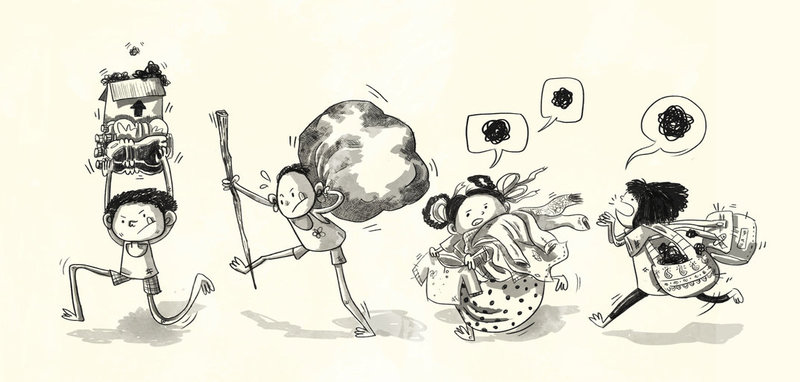
Favourites From Other Publishers
1. 'Bhimrao Ambedkar: The Boy Who Asked Why' by Sowmya Rajendran and Satwik Gade (Tulika)
2. 'The Princess with the Longest Hair' by Komilla Raote and Vandana Bist (Katha)
3. 'The Lonely King and Queen' by Deepa Balsavar (Tulika)
4. 'The Sackclothman' by Jayasree Kalathil (DC Books)
5. 'Dear Mrs. Naidu' by Mathangi Subramanian (Young Zubaan)
6. 'Simply Nanju' by Zainab Sulaiman (Duckbill Books)